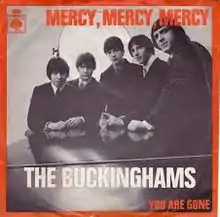Mercy, Mercy, Mercy
"Mercy, Mercy, Mercy" is a jazz song written by Joe Zawinul in 1966 for Julian "Cannonball" Adderley and his album Mercy, Mercy, Mercy! Live at 'The Club'. The song is the title track of the album and became a surprise hit.[1] "Mercy, Mercy, Mercy" went to #2 on the Soul chart and #11 on the Billboard Hot 100 chart.[2]
| "Mercy, Mercy, Mercy" | ||||
|---|---|---|---|---|
 | ||||
| Single by The Buckinghams | ||||
| from the album Time & Charges | ||||
| B-side | "You Are Gone" | |||
| Released | March 1967 | |||
| Recorded | Columbia Studios, New York, NY | |||
| Genre | Pop, soul | |||
| Label | Columbia | |||
| Songwriter(s) | Joe Zawinul | |||
| Producer(s) | James William Guercio | |||
| The Buckinghams singles chronology | ||||
| ||||
| "Mercy, Mercy, Mercy" | |
|---|---|
| Song by Cannonball Adderley | |
| from the album Mercy, Mercy, Mercy! Live at "The Club" | |
| Released | 1966 |
| Recorded | Capitol Records (Los Angeles), October 20, 1966 |
| Genre | Soul jazz |
| Length | 5:10 |
| Label | EMI |
| Songwriter(s) | Joe Zawinul |
| Producer(s) | David Axelrod |
Original version
The original version was performed by: Cannonball Adderley (alto saxophone), Nat Adderley (cornet), Joe Zawinul (piano, electric piano), Victor Gaskin (bass) and Roy McCurdy (drums). The theme of the song is performed by Zawinul on a Wurlitzer electric piano previously used by Ray Charles.[3]
Buckinghams cover
"Mercy, Mercy, Mercy" has been re-recorded numerous times, most notably by The Buckinghams, who reached #5 in August 1967, adding lyrics to the tune. Musicians on the Buckingham's version included James Henderson, Lew McCreary and Richard Leith on trombone, Bill Peterson, Bud Childers on trumpet, John Johnson on sax, Lincoln Mayorga on Wurlitzer electric piano, Dennis Budimir on guitar, Carol Kaye on bass, and John Guerin on drums.
Chart performance
Theme
The first part of the theme is played twice and is completely made of notes from the major pentatonic scale of the first degree.
Structure and chord progression
The tune is in the key of B-flat major and has a 20-bar structure with four distinct sections. The chord progression is mainly made of dominant-seventh chords on the first, fourth and fifth degrees, giving the song a bluesy feeling although it does not follow a typical blues progression. The subdominant (IV) chord in the beginning section emphasizes this bluesy feeling. In the second section, the tonic chord alternates with a second-inversion subdominant chord, creating a parallel to the I-IV-V progression (in which the tonic moves to the subdominant).
References
- in Feb. 1967. "This album gave birth to a Top Ten single of the title tune, much to the astonishment of many..." Michael Cuscuna 1995 Capitol Reissue CD liner notes
- Whitburn, Joel (2004). Top R&B/Hip-Hop Singles: 1942-2004. Record Research. p. 24.
- Keyboards (german keyboard magazine), 06/2007 http://www.keyboards.de.
- "Item Display - RPM - Library and Archives Canada". Collectionscanada.gc.ca. 1967-08-05. Retrieved 2018-01-14.
- Joel Whitburn's Top Pop Singles 1955-2002
- "Item Display - RPM - Library and Archives Canada". Collectionscanada.gc.ca. Archived from the original on 2016-08-12. Retrieved 2016-10-01.
- "Top 100 Hits of 1967/Top 100 Songs of 1967". Musicoutfitters.com. Retrieved 2016-10-01.
- "Cash Box YE Pop Singles - 1967". Tropicalglen.com. 1967-12-23. Archived from the original on 2018-09-30. Retrieved 2016-10-01.
